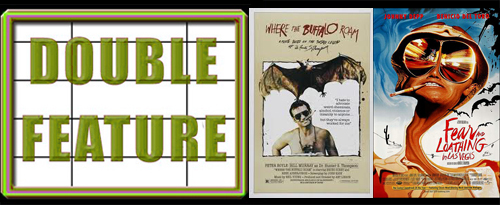
The double feature is cinema appreciation at its most basic. The mere act of pairing two films together – whether the bond be subject matter, central theme, a certain actor or filmmaker, or something outside-the-box conceptual – causes them to take on a different sort of life. A new relationship is formed with the viewer. You pay attention to new aspects and journey down unfamiliar avenues when you view films through Double Feature Goggles. Even when the linking bond is comically tenuous, the double feature magic is there. And I’m the kind of guy who derives just as much pleasure from creating a double feature as I do from watching one. Aside from amusing myself, hopefully I can give some people ideas for their next movie night.
The Double Feature: Where the Buffalo Roam (1980) and Fear and Loathing in Las Vegas (1998).
The Connection: Dr. Hunter S. Thompson and his relationship with attorney Oscar Zeta Acosta, aka Carl Lazlo, Esq./Dr. Gonzo.
Generally speaking – in terms of this column – I don’t like pairing a good movie with a mediocre or bad movie purely for the sake of creating a strong thematic bond, but in certain instances (such as this one) that thematic connection is interesting enough to justify the inclusion of a weak film. Such is the case with Where the Buffalo Roam, which is not a particularly good film, but becomes fascinating when viewed alongside Fear and Loathing.
Film 1: Where the Buffalo Roam opens with Hunter S. Thompson (Bill Murray) clad in one of his iconic outfits – here shirtless with a bright orange vest on, sunglasses, visor, cigarette holder clenched between his teeth – holed up in his manly cabin’s writing room, snow visible out the window (it almost seems like the set of a play). He’s starring down a deadline with writer’s block, his editor’s fax machine (or whatever they were called back then) incessantly chirping at him. He pours himself some Wild Turkey. He shoots the fax machine with his gun. Then he starts writing in the past tense about his buddy Carl Lazlo (Peter Boyle). Then the film moves into a loosely strung together series of vignettes marking several adventures the two men had together, spanning from the late 60’s when Lazlo was a crusading attorney fighting for the rights of the counter culture, to the 70’s when Lazlo has become tangled up with Latin revolutionaries.
The film was the directing debut of Art Linson, who is a great producer (Fast Times At Ridgemont High, plus numerous notable De Palma and Mamet films), and not such a great director. The widly uneven and unfocused script by John Kaye is credited to “the legend of Dr. Hunter S. Thompson,” and is a hodgepodge of Thompson’s Fear and Loathing on the Campaign Trail ’72, Fear and Loathing in Las Vegas and several shorter works, like Thompson’s obituary for Lazlo’s real-life counterpart, Oscar Zeta Acosta, “The Banshee Screams for Buffalo Meat.” This obit is where the film’s title comes from. Thompson’s own title was a reference to Acosta’s autobiography, Autobiography of a Brown Buffalo.
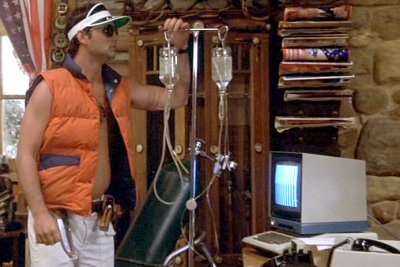
Film 2: Thompson first sold the rights to his landmark book – which features Thompson’s brilliant career defining “wave speech” – in the early 70’s, and happily watched Hollywood fail to make it happen time after time (he was horrified when he realized Where the Buffalo Roam was actually going to get made). The film was originally to star Jack Nicholson and Marlon Brando as Raoul Duke and Dr. Gonzo. Then it was Dan Aykroyd and John Belushi. John Malkovich was briefly considered for the role of Duke. Ralph Bakshi had wanted to do an animated version. Martin Scorsese and Oliver Stone each tried to make the film happen. In the 90’s John Cusack was attached to play Duke, but when Thompson himself happened to meet Johnny Depp, he became convinced that only Depp could play his alter ego (both men grew up in similar regions of Kentucky). Repo Man‘s Alex Cox was hired to direct Depp and Del Toro, but Thompson hated Cox’s script, and Cox eventually left over “creative differences.” Terry Gilliam was brought in. Mad genius happened, as Gilliam gave visual extensions to Thompson’s fevered words about the drugged-out plunge that he and Acosta took into the Vegas strip when Thompson was supposed to be covering a Mint 400 motorcycle race.
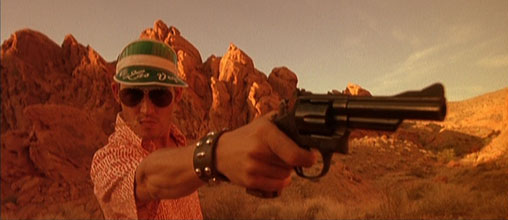
Double Feature Goggles: Where the Buffalo Roam is a middling-going-on-bad movie. Fear and Loathing is a masterpiece, of both visual execution and off-kilter storytelling. The films could not be more different, yet it is fun to look at all the ways that they inevitably overlap due to their source.
Where the Buffalo Roam‘s grand failing is that it has no perspective. On Thompson. On Lazlo. On itself. Which is a shame, because it is actually a funny movie when it figures out what gear it is supposed to be in (do kids still understand stick-shift metaphors?). I really have no idea what Kaye and Linson want us to think about Hunter Thompson, and the film is stuck hovering between two wildly different approaches to the character. On one end you have a take typical of the Animal House/Stripes era, where Thompson is treated like a subversive party hero, freaking out the squares and spreading a good time wherever he goes like the Johnny Appleseed of drugs and booze. Then on the other end, you have a film that seems to be trying to present Thompson as an actual person, as an eccentric artistic genius whose writings are considered important by many people. And these two takes don’t coexist well in harmony as presented by the filmmakers. Gilliam on the other hand made the wise decision to present Thompson as a caricature in Fear and Loathing, as the visual personification of Thompson’s weird words and nothing more.
Thompson was such a strange being, in attitude, in dress, in his famously unique speech rhythm, that even Bill Murray can’t resist doing an impression of him. At times it works (such as a scene where he’s roped two Mexican hotel employees into playing football in his room), but at other times Murray doesn’t seem fully committed. Or possibly he just didn’t possess the ability to go full Thompson. It is nonetheless fun to watch Murray lurch about and mumble in a style that you’ll be surprised to discover Johnny Depp did not totally create. Where the actors/films’ two approaches to Thompson most differ is that Buffalo presents Thompson as a cool operator who ends up dominating every situation he’s in, whereas Gilliam and Depp present Thompson as more of a passive observer, sucked up by the current of crazy events and often terrified by what is happening to him. Murray’s Thompson never seems fazed by anything, not even when he’s being shot at by a machine gun. Oddly enough, in a lot of ways Depp’s cartoon Thompson feels more like a rounded, believable person than Murray’s Thompson.
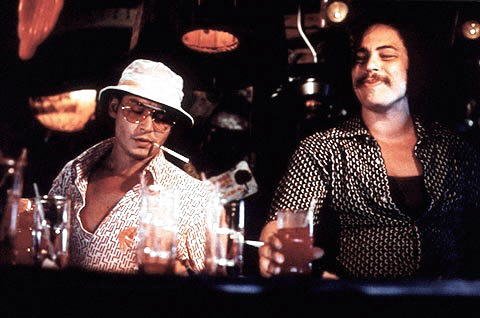
While there is a lot of overlap between Murray and Depp’s Thomsons, there is none between Peter Boyle’s Lazlo and Benicio Del Toro’s Dr. Gonzo. At the top of the film Lazlo actually seems like an intelligent respectable human (just with crazy hair). It frankly doesn’t make much sense that he’d want to be friends with the obnoxious Thompson. But when the film jumps forward in time, next we meet Lazlo he has become crazed, egging Thompson on to act irresponsibly. There is no cohesion to the character and we never really learn what he’s about. Or why the two men are even friends in the first place. The same could be said for Fear and Loathing, but the ridiculous nature of that film never inspires you to ask such questions. Dr. Gonzo is referred to as Duke’s attorney, and you get the sense the man in on retainer in some capacity. The reality of the men’s relationship was much closer to that in Buffalo, but their story was done a complete disservice by such a shallow presentation.
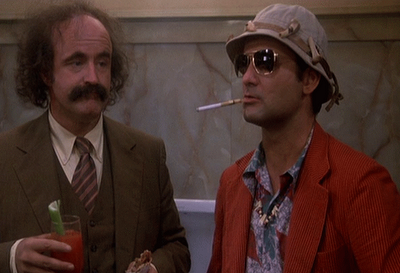
Really Buffalo makes a mistake in trying to present a chronicle of Thompson’s rise to fame and his actual relationship with Acosta, as though the film were a casual biopic. Yet any film trying to tell the actual story of Hunter S. Thompson would be a pitch black journey into human destruction. It wouldn’t be much of a comedy. It’s fun to see the character of Thompson feeding his dog Wild Turkey while writing in his wilderness hideaway, but trying to present any semblance of Thompson’s actual story into this scenario makes everything we’re seeing total bullshit. Bill Murray’s Thompson never seems to get drunk or fucked up no matter how much he puts into his body, while the actual Thompson was slowly imploding towards the end of the 70’s, his writings becoming infrequent and incoherent. I’m not saying that the film needed to be presenting the truth. Just opposite. I think it should have moved far away from it. Then film should have just given us the wild man and left Lazlo out of it completely. A movie of Bill Murray stumbling through wacky situation after wacky situation may have been a poor commentary on what Thompson’s politically charged writings stood for, but it would have been a much better film. You can’t hint at the real Thompson without actually going there. Even Thompson’s famous hatred of Nixon doesn’t make sense within the context of the film unless you are familiar with Thompson already. The character of Thompson as presented in the film doesn’t seem like he gives a shit about anything. Why should he care about politics?
Fear and Loathing takes the Withnail & I approach to substance abuse. While the debauchery is almost always played for laughs, Depp and Del Toro get believably fucked up. And Fear and Loathing‘s greatest strength over Buffalo is that while it never gets into the darkness that lurks inside Thompson the character, it touches on that darkness by taking our passive observe, Duke, to some truly dark places (namely that amazing and scary diner/pie scene with Ellen Barkin). Even as silly caricatures, Fear and Loathing gets far deeper into the seedy terror that Thompson and Acosta’s adventures must have been.
It’s interesting where the films actually overlap. They share few exact moments, though both films do feature Fear and Loathing‘s frightened hitchhiker scene (Fear and Loathing‘s version is much funnier). But the movies use a lot of the same gags: convertibles left parked in inappropriate places, an impossibly trashed hotel room, the way Thompson will carry a drink with him at all times.
On it’s own there is no reason to see Where the Buffalo Roam, but viewed academically with Fear and Loathing in Las Vegas it is kind of a blast to see how two different generations of actors and filmmakers chose to present Thompson and Acosta.
Previous Double Features
The Commitments/The Blues Brothers | The Set-Up/High Noon
The Plague Dogs/Secret of NIMH | The Old Dark House/Dolls
The Fury/Firestarter | Alligator/Q